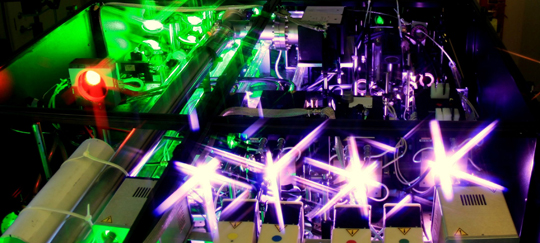HERCULES laser rivals a synchrotron for short pulse x-ray beams
By using the wiggling motion of electrons in a plasma bubble generated by the ultrashort laser pulse, researchers produced X-rays comparable to that produced in a synchrotron facility.

 Enlarge
Enlarge
Researchers in the High Field Science group of the Center for Ultrafast Optical Science have recently used the high-intensity, table-top HERCULES laser to demonstrate X-ray beams with peak spectral brilliance rivaling those generated in expensive and large synchrotron particle accelerators.
The National Synchrotron Light Source II, for example, is expected to be a half-mile long and cost more than $900 million to construct. By using the wiggling motion of electrons in a plasma bubble generated by the powerful, ultrashort laser pulse, the researchers produced a bright, collimated beam of X-rays comparable to that produced in a synchrotron facility.
Throughout history, X-ray machines have opened new frontiers in science. Earlier generations illuminated the structure of DNA and brought the first radiographs, which enabled imaging the human body. The X-rays produced by HERCULES are not only bright and energetic, but also have a degree of spatial coherence, allowing phase-contrast imaging of biological samples. This exploits the diffraction of x-rays to form images of the interfaces of soft tissue, rather than the traditional absorption radiograph. In addition to this, the X-ray pulse is expected to be an unprecedented sub-10 fs in duration, which should allow temporal resolution of atomic processes, thus opening up many new possibilities for University researchers.
The researchers involved include EECS and NERS professor Karl Krushelnick, research scientists Vladimir Chvykov, Galina Kalintchenko, Anatoly Maksimshuk, and Victor Yanovksy, as well as researchers at Imperial College London and Instituto Superior Technico Lisbon. The work is described in the article, “Bright spatially coherent synchrotron X-rays from a table-top source,” in Nature Physics 6, 980-984 (2010).
U-M Press Release: Shortest-pulse X-ray beams could illuminate atomic, molecular interactions
The University Record: Shortest-pulse X-ray beams could illuminate atomic, molecular interactions
In the Media
A stellar achievement: Magnetized space winds in the laboratory
The international team that includes Prof. Louise Willingale is investigating the role of intense magnetic fields dragged by high-speed plasmas through astrophysical environments. HERCULES was used in the experiments.


 MENU
MENU